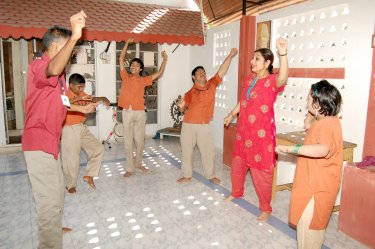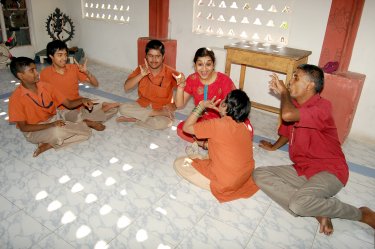
|
 |

|
 |
Theatre for holistic development - Ambika Kameshwar, Chennai e-mail: ambika.rasa@yahoo.in September 28, 2012 Natya is the term given by Bharata muni in his Natya Sastra to represent Indian Theatre. Bharata defines Natya as the representation of the states of all the three worlds. trailokyasya sarvasya natyam bhavanukirtanam (NS chI v 106) Life and theatre therefore are not apart and an understanding of life through theatre is realistic, holistic and enjoyable at the same time. The grace of the lord made me focus on the wonder of Indian theatre and its magical influence on all coming within its orbit and codify it as a unique methodology, leading one to a holistic understanding of oneself, and, leading one thereby to holistic self-development. Indian Theatre, as other forms of Theatre, is essentially for representation through performance and includes in its ambience drama, dance, music and stage art and craft to carry forward the communication of the story to be told. Ever since I was a little girl I was exposed to the wonderful art forms of dance and music. I always got so much from them that I believed strongly in dance and music being far more than 'merely' performing arts. Structured dance and music and their performance is, I believed, and believe, only a part of the whole. For me, in the movement of the trees, the leap of the deer, the prancing of the waves, in the laughter of children, in the tears of the afflicted and expressions of the proud parent…In every single movement of the universe, there is dance and in every single sound there is music. My belief would have remained a belief, but for god giving me opportunity after opportunity for reinforcing my belief and helping me structure dance, music and drama into a methodology that does not only result in performance but goes far deeper seeking and fulfilling every developmental need of an individual. From 1982, when I started working with the visually impaired children at Ramana Maharishi Academy for the blind, Bangalore and in 1985 when I volunteered to teach dance and music to children of Spastic Society of India (now Vidya Sagar) till I started Rasa – Ramana Sunritya Aalaya in 1989, I found fulfillment in structuring and documenting the new methodology of holistic self development which I first called C.M.E. (Creative Movement Education) and later changed the term to T.H.D (Theatre for Holistic Development) for it covered the scope of the methodology more fully. 

Each individual child I would work with, I would first understand the needs, set the goals that would need to be achieved and work out activities of dance, music and drama to help him/her to achieve those goals. So, we would have fun together and learning would take place simultaneously – spontaneously, whether it was a child with Mental Retardation, Cerebral Palsy, Down's Syndrome, Autism Spectrum Disorder, or Learning Disability, the complete assessment of current capacity would be done and skills to be achieved would be worked on. In fact, the need would be different for each child, but the limitless scope of the creative art forms provided ample opportunity to tailor make the developmental lesson plan for the children. The obvious development of these children was intensely rewarding. I would always say, "This is such a fun way to learn" and seeing the stress that "normal" children in mainstream schools go through, it would be ideal to provide them with THD inputs, as it is such a fun way to learn. But I do realize that while THD is scientifically structured, developmentally focused and universally applicable, it also needs much more time to be devoted for the development of and learning of any given concept/skill. Hence in mainstream schools, THD could be used to learn some skills and as a welcome, constructive change from routine learning. As a process of rehabilitation, however, where active learning is of paramount importance, it is an ideal answer to holistic development. So it is that at Rasa, the children dance to be provided with mobility training and sing to better their vocalization skills. Drama teaches them interpersonal skills and Arts and crafts provide for concept development and so on. These are just some of the skills that I have mentioned - THD results in the complete development of the individual. I documented this methodology as a scientifically structured method of holistic development for all – no differences, no barriers – only joyous learning. When I started this special work, I was working alone and I soon realized, that alone I could reach out only to a select few but if I could work with like-minded people who would stand beside me and help me in my mission of spreading THD as the most wonderful learning methodology, I could reach out to so many! So it was that I registered the organization Rasa – Ramana Sunritya Aalaya in1989. Initially my colleagues would watch me work with the children and learn from that. Later in 1994, we started a Capsulated Teachers Training Diploma Course to train those who would like to work with THD and Special Needs. Today, we at Rasa are proud and happy to be reaching out to several hundreds of special children, engulfing them in the joy of the Theatre Arts and helping them attain their full potential as well. The word is spreading – the methodology is reaching more, bringing more smiles on the faces of more children. This is my story in brief. Today, anyone who would like to embrace this methodology as a way of life, and/or to empower others by waving its magical wand, the Ramakrishna Mission Vivekananda University has extended it to all as a University recognised PG Diploma training program. The magic continues… Dr. Ambika Kameshwar is the Director of RASA, Chennai. www.rasaindia.org  Comments Great endeavour; an indispensable need of the present. I am extremely glad to note that in India too such beginnings have been made. Maybe there are more such researchers, but unfortunately we lack sufficient published documented evidences with scientific structuring, in the areas of research related to "Art at the applied level". Those working in the said areas may kindly refer to the subject, 'Neuroaesthetics' to which Dr. V.S. Ramachandran (University of Chicago) has made commendable contributions. Lot more could be done in education and health care. - C.P. Unnikrishnan (Oct 1, 2012) Post your comments Please provide your name and email id when you use the Anonymous profile in the blog to post a comment. All appropriate comments posted with name & email id in the blog will also be featured in the site. |